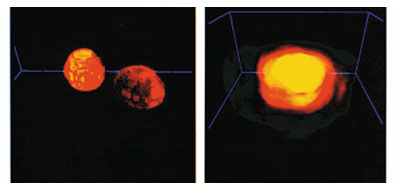Supernovae and gamma-ray bursts are the biggest explosions in the universe bar the Big Bang. The former,
occasionally visible with the naked eye,
have been chronicled for centuries,
while gamma-ray bursters had to wait for modern technology before being revealed. The study of these explosions provides valuable information on the evolution of the universe. In this special edition,
Astrowatch previews some of the presentations at the Symposium on Supernovae and Gamma Ray Bursts at the Space Telescope Science Institute in Baltimore on 3-6 May.
Gamma-ray bursts

The most powerful objects in the
universe are also the
most mysterious.
Gamma-ray bursts can emit more energy in a few seconds than all of the
1011 stars in our galaxy emit over a few days.
This colossal concentration of energy is also thought to produce ultrahigh-energy cosmic rays protons of more than 1019 eV.
Cambridge astronomer Sir Martin Rees has spent a number of years working on the theory of gamma-ray bursts. At the May symposium he speaks about their diversity and how theory is finally catching up with observation. For many years,
astronomers did not know how far away these mystery bursts were. However,
recent identification of their optical counterparts has shown that they are far outside our galaxy.
Today the
popular model is of a spinning black hole with a torus of material swirling around it,
which feeds two hyper-relativistic jets (Lorentz factor typically more than 100).
The rapid infall into a newly formed black hole releases a burst of energy lasting a few seconds that transforms into gamma rays.
The afterglow comes from the
subsequent outflow of material slowed down by the
interstellar medium.
The complicated time structure of most bursts can be explained by a succession of internal shocks as the
jet changes speed.
Most observations to date fall into the
category of long bursts,
but Sir Martin believes that we may not be seeing the
real distribution as the
Bepposax X-ray satellite is not sensitive to short bursts.
Long bursts are thought to be caused by enormous hypernovae explosions collapsing into a spinning black hole.
Short bursts are thought to be coalescing binary stars collapsing into a spinning black hole.
There are two main candidates for the mechanism governing the prodigious energy release. First,
thermal neutrinos produced in the hot swirling debris are converted into electronpositron pairs. Second,
the outflow is caused by an electromagnetic torque,
like that in pulsars. A magnetic field of 1015 gauss and 1 ms orbit could produce the observed luminosity.
Gamma-ray bursts are of wide interest to physicists. “They are very interesting as probes of great distances,
” said Sir Martin,
“moreover,
events that give gamma ray bursts are also likely to emit gravitational waves.” Some quantum gravity effects may also be observable.
Accelerating universe
The universe is expanding at an accelerating rate,
studies of supernova explosions are now suggesting. This result has revived talk of Einstein’s cosmological constant. Saul Perlmutter,
who is head of the Supernova Cosmology Project,
gives an update on his work in the field.
Some supernova explosions – type Ia – always have essentially the same luminosity. Knowing the luminosity of the explosion means that its distance can be calculated,
and observing how the light is red-shifted shows how much the universe has expanded since that point in spacetime.
Perlmutter and
his team have studied altogether some 80 high red-shift type Ia supernovae.
Their results imply that the
universe was decelerating for the
first half of its existence,
and
then began accelerating approximately 7 billion years ago.
Perlmutter said: “this presumably was due to the
universe becoming large enough that the
mass became so dilute that its effect was overwhelmed by the
accelerating effect of the
vacuum energy density the
cosmological constant.”
For the Supernova Cosmology Project,
most of last year was spent hunting for “loopholes” that might explain away the need for a cosmological constant. The group has observed more supernovae,
including the furthest ever detected,
but the results have not changed. “We are now in the midst of a new search for nearby type Ia supernovae,
so that we can check them more rigorously for even more arcane problems that could distort our high-red-shift results,
” said Perlmutter. “This time we are nicknaming them after Shakespeare characters,
so we have a Petruccio,
a Hamlet,
a Friar John…”
Great balls of fire
Last month,
Astrowatch reported the
first direct optical observation of a gamma-ray burst.
For a few seconds this emitted more light than the
rest of the
universe.
Theorists can now compare their models from a new perspective.
Whatever the
mechanism turns out to be,
attempts to explain gamma-ray bursts have almost inevitably focused on some generic picture of a highly relativistic fireball.
Tsvi Piran of Jerusalem’s Hebrew University shows how this model fits the
data.
A reverse shock at the
moment of the
“afterglow” following the
gamma-ray burst could give the
optical effects.
The Hubble Space Telescope has shown a decrease in the
afterglow,
which Piran suggests could be caused by the
jets spreading out.
He estimates the
angle of the
jet to be around 10°,
and
therefore the
actual energy of the
burst to be around 1052 ergs,
which is comparable to that of a supernova.








